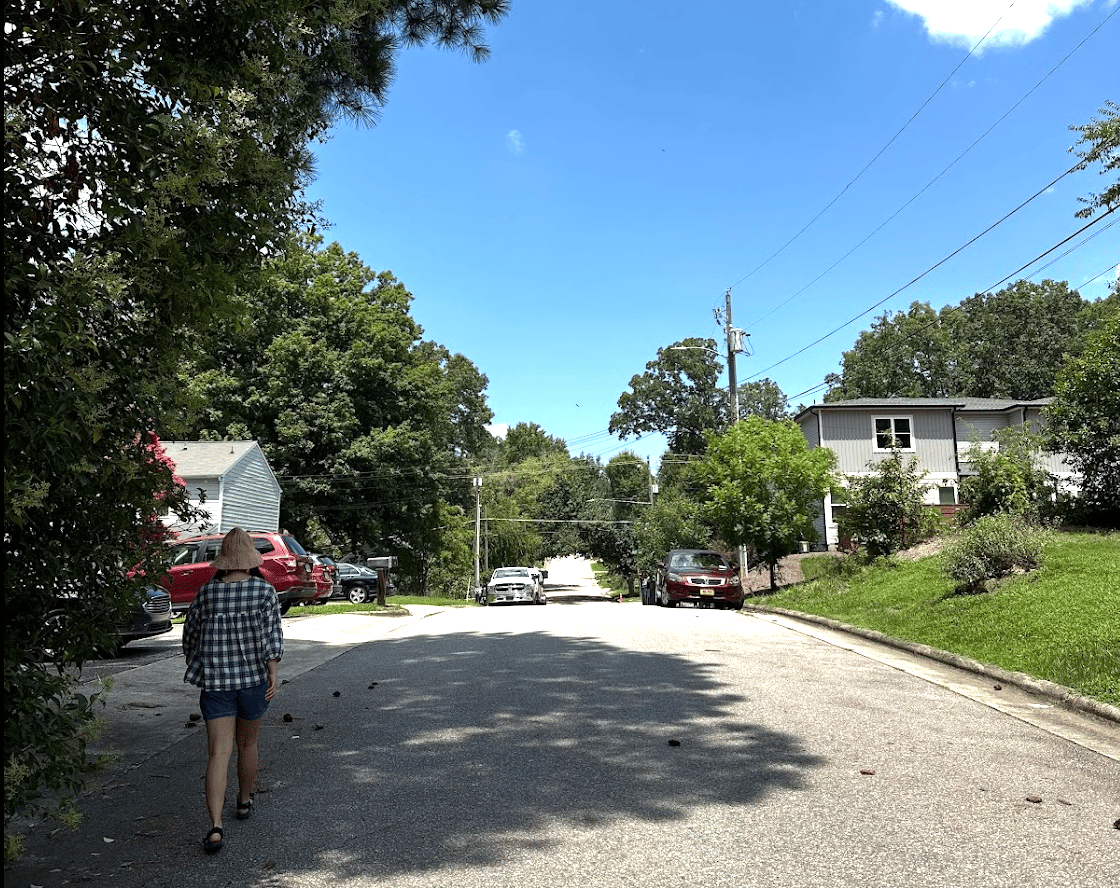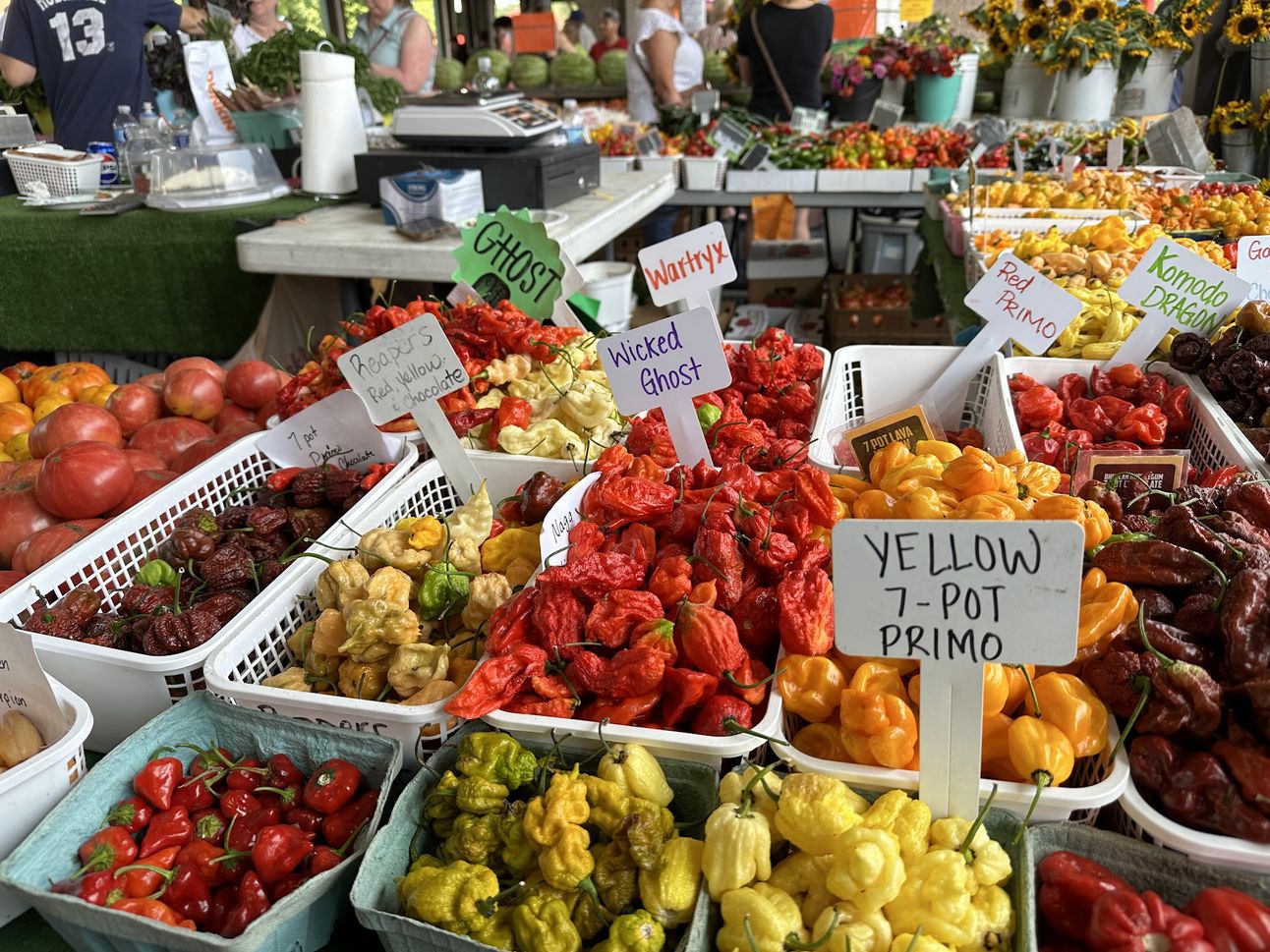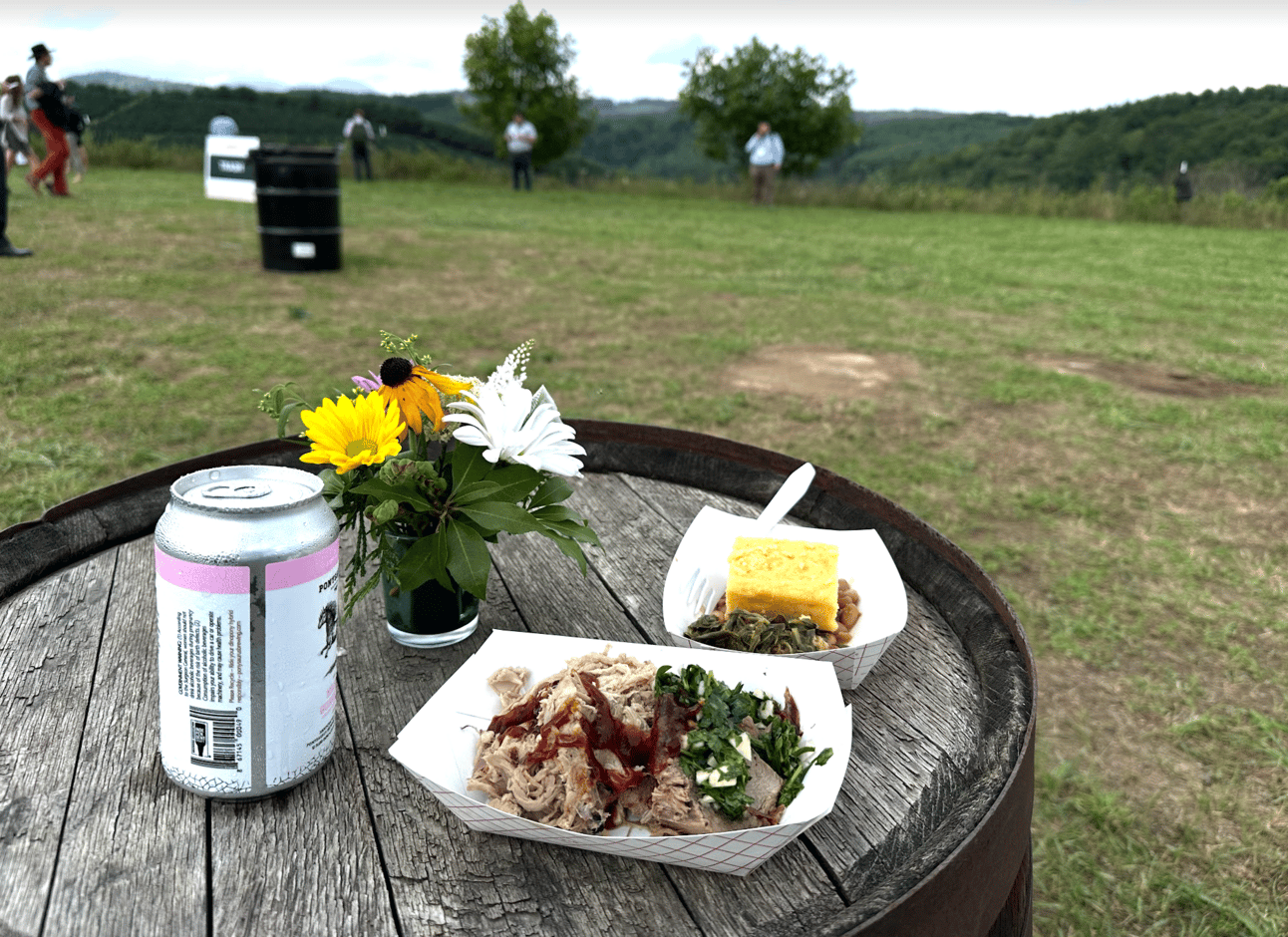Last week, I got the chance to travel all throughout North Carolina.
I spent 3 days in Raleigh, 3 days in Boone (for the MEAT 🍖 conference), 0.5 day in Greensboro, and 3 days in Charlotte.

Charlotte → Raleigh → Boone → Greensboro → Charlotte
⛰️ Discovering North Carolina
1. North Carolina is green!!!
Apparently North Carolina’s climate is considered sub-tropical, and even in the cities it was dense with trees and insects (so many beetles). To me, the weather felt similar to Hawaii – it was warm and humid, with occasional random showers in the middle of the day.

A typical street in North Carolina
2. Everyone I met was really nice.
People would smile at us, strike up friendly conversations, or give us a warm introduction to wherever we were visiting.
I didn’t expect to be able to connect with people so easily in North Carolina. I’ve found that on the West Coast, while people are polite, they generally mind their own business and don’t feel as “approachable”. Up until now, I didn’t really get the comments on Reddit about how Americans are known for being super friendly, but everyone I met in North Carolina was super easy to talk to and felt like they genuinely wanted to chat with you, rather than just being polite.
3. Food is cheap, brown, and LARGE
Maybe the biggest culture shock I had was the food in North Carolina. North Carolinians love their fried food, biscuits, and meat. Not to mention, sweet tea was everywhere, and it honestly tastes more like sugar than tea.
Looking around at the food options, it was clear that the food that was most accessible was also not the healthiest. At restaurants, Christine and I could place a single order for the two of us and usually have leftovers. At barbecue or diner spots, it also seemed to be standard practice to get a complimentary appetizer of hush puppies aka fried cornbread.

North Carolina is known for biscuits, barbecues, and calabash seafood
Don’t get me wrong, the food was delicious. But I could see how if this were your regular diet, you might run into health issues later down the line (or at least have bad poops).
In an effort to balance out our diet a bit, Christine and I got groceries to remix with our leftovers and add some fiber (turning it kind of asian in the process).
Pro tip: Instant rice in a bag has the perfect texture for fried rice

Egg fried rice with broccoli and leftover fried shrimp
4. There’s also a vibrant local farm-to-table scene
Christine and I got to visit the State Farmer’s Market in Raleigh, and it was pretty epic. Berries, peaches, and peppers were in season, and every stall was overflowing with color (unlike our restaurant meals).

This stall had ghost peppers and the legendary Carolina Reaper
I later learned from one of the staff at the Center for Environmental and Farming Systems (CESF) at North Carolina State University that North Carolina’s legacy of having small, highly profitable tobacco farms meant that after the state transitioned away from tobacco, there were still many farmers who had small plots of land as opposed to consolidated mega-farms.
Hearing the CEFS staff talk about food justice/equity, conservation, and providing economic opportunities really reminded of the conversations I was having in my food systems class at UC Berkeley. I guess even though we’re across the country in two very different states, people aren’t so different after all.
5. North Carolina seems kind of… liberal?
Or at least a lot more liberal than I expected. I had assumed pretty much any state in the South was a red state (except Georgia), but I later learned that North Carolina is considered a purple state, and currently has a Democratic governor (Roy Cooper).
While North Carolina isn’t considered one of the swing states for the 2024 election, I could certainly see evidence of progressiveness / social liberalism (lots of inclusive messaging + support for the LGBTQ+ community). It probably helped that I was mostly in cities and college campuses, but on our road trip from Raleigh to Boone we passed through some smaller towns, and I was surprised that the MAGA vibes seem to be stronger in rural California/Oregon compared to the places we passed through.
6. Bonus: Infrastructure and public spaces
Unlike the I-680 near San Jose, North Carolina’s roads were all in fairly good condition, even out in Boone. The streets were also generally very clean. For public transportation, Charlotte in particular seemed to have a functional light rail with some buses stretching across the city, but I would say none of the places we visited were all that walkable.
We were pleasantly surprised that in Raleigh, all the major museums were free! We only went to the science museum due to time, and even just the science museum had probably enough to see for an entire day. We got to visit the DinoLab, where I saw actual T-rex and Triceratops fossils for the first time (not just replicas!).

Real fossil of a small T-Rex
🍖 Volunteering at a MEAT conference
Going to a meat conference wasn’t really on my radar for 2024, but when Christine signed up to volunteer for the Carolina Meat Conference, she asked the organizer if I could tag along. They said yes!
It felt a bit strange to be the only person at the conference not closely tied to agriculture/food systems. It seemed like most people at the conference were either farmers or worked at University extensions that supported the agricultural industry. I did my best to appear relevant by saying I build marketing software for small businesses, since there were lots of small businesses there.
I volunteered to help run 4 different event sessions:
-
Shipping Meat Products: This was essentially a practical guide to shipping / packaging for Direct-to-Consumer meat businesses. The speakers were a husband-and-wife duo, and they brought all the packaging (boxes, refrigerant, wrapping) that they had used and tested, sharing the learnings from their trial and error with the audience. Pretty cool to see what it takes to ship meat over the mail, but also it’s kind of crazy how much packaging is used, and how much it adds to the overall cost of the meat.
-
Sell More Online (Even If You Don’t Have an Online Store): Online marketing 101 for small businesses. During this session I learned that several farmers use Mailchimp for their email / SMS marketing, which made me feel a bit more relevant 🙂
-
Increasing Customer Spending at Farmers Markets Using Your Own Data: This was basically business intelligence 101 for farmer’s markets, pairing practical advice for how to set up your stall at a farmer’s market with purchasing data on Square to make decisions on pricing, packaging, and inventory.
-
Is Technology Right for You and Your Dairy Business?: This session focused on precision agriculture, which includes the tools and technologies use to monitor, analyze, and optimize farm operations. I was very surprised to see how advanced some of the technology was. Did you know farmers can predict mastitis (udder infection) using machine learning based on milk yield, rumination time, and milk electrical conductivity? The speaker wove in data science / statistics concepts (e.g. classification sensitivity / specificity) into her talk that I really didn’t expect to hear given the audience was mostly farmers, not data scientists at a Silicon Valley tech company. Some farmers brought up concerns about having to share their data with retailers or the government in the future, which seemed to be a running theme with several farmers I heard from throughout the conference. I realized the AgTech industry has a lot of potential going forward, but it seems like the biggest challenge right now is helping farmers bridge the knowledge gap to understand the benefits of adopting new technology, which will have to include conversations about things like data privacy / transparency.
One of the highlights of my time at the conference was listening to Dr. Temple Grandin speak live (I also got her to sign a book!). I had just watched her movie the weekend beforehand, and she’s quite a funny person in real life. She talked about the basics of livestock handling and facility design – reiterating several of the points covered in the movie:
-
Animals get scared
-
Don’t yell, scream, or kick at animals
-
Design facilities that don’t surprise them by building walls that block their vision (e.g. a truck being loaded) and removing distracting objects like chains
-
Make sure floors are non-slip so animals don’t fall and hurt themselves
A lot of these principles seem like common sense, but it’s clear that Dr. Grandin had to do a LOT of retraining, speaking, and campaigning for farms to start adopting these principles. Apparently one of the best ways to get farms to adopt these practices is by getting their customers (e.g. McDonalds, Burger King) to understand these principles. Christine also raised her hand and got to ask a question live!

On Day 1, I think I maxed out my ‘Murica experience when I ate barbecue and drank beer off a barrel in the middle of the Great Smoky Mountains with country music playing in the background
Overall, I had a great time at the conference. It was fascinating to enter a world so different from my own, and I felt inspired after learning about the different problems this industry is focused on solving. I saw a ton of opportunities for how technology, data, and new operational practices could address these problems, some of which are standard practice in the tech industry. I feel optimistic that I can take some of the stuff I’m learning now at a big tech company and apply them in new ways to make a more meaningful impact on society in the future.
❤️ My favorite things this week
-
Crying in H-Mart – I finally read this book after hearing about it from friends and acquaintances over the years. It’s a beautifully written memoir, with the author describing her experience taking care of her mother undergoing cancer treatment, tying her story together with eloquent descriptions of food. Although I’m not Korean, the author touched on several themes including her Asian-American identity, her relationship with her family, and her relationship with food that resonated with my own experiences. Also, it’s kind of cool to see the legend Maangchi being mentioned in a book 🙂
That’s all for this week – see you in the next one!
Tim
